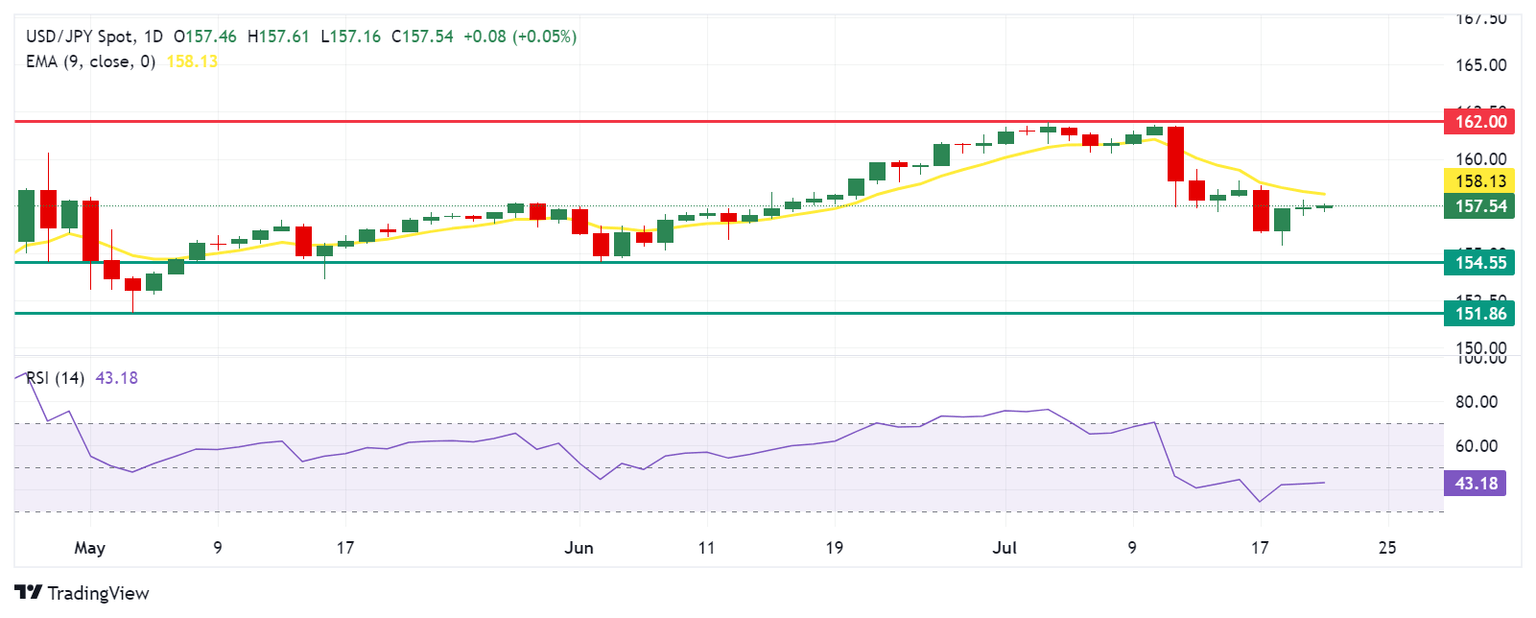Japanese Yen improves as US Dollar remains weak due to rising bets of Fed rate cuts
- The Japanese Yen inches higher due to the hawkish sentiment surrounding BoJ’s policy stance for next week.
- Japan’s Prime Minister Fumio Kishida stated that normalizing the BoJ’s monetary policy would help support a growth-driven economy.
- US President Joe Biden abandoned his re-election bid and endorsed Vice President Kamala Harris to face Republican Donald Trump.

The Japanese Yen (JPY) breaks two days of losses on Monday. Traders are gearing up for the Bank of Japan’s (BoJ) policy meeting next week, where an interest rate hike might be on the table to support the JPY. Japan’s Prime Minister Fumio Kishida stated that normalizing the central bank’s monetary policy would aid Japan's shift to a growth-driven economy, according to Nikkei Asia.
Speculative short positions in the Yen, which had risen to their second-highest level, have started to decline following Japan's suspected Yen-buying intervention this month, which surprised the market. As of Tuesday, Yen short positions held by market players such as hedge funds totaled a net 151,072 contracts, according to the US Commodity Futures Trading Commission. This marks a decrease of 30,961 contracts from the previous week and is the largest drop since May 7, when short positions fell by 33,466 contracts, according to another report by Nikkei Asia. Traders remain vigilant about the possibility of further interventions.
The USD/JPY could limit its upside as the US Dollar (USD) faces challenges due to rising bets on a Federal Reserve (Fed) rate cut in September increase and concerns about the fragility of the US labor market persist. According to CME Group’s FedWatch Tool, markets now indicate a 91.7% probability of a 25-basis point rate cut at the September Fed meeting, up from 90.3% a week earlier.
Daily Digest Market Movers: Japanese Yen remains weak despite intervention threat
- US President Joe Biden abandoned his re-election bid on Sunday under growing pressure from his fellow Democrats and endorsed Vice President Kamala Harris as the party's candidate to face Republican Donald Trump in the November election, according to Reuters.
- Federal Reserve Bank of New York President John Williams stated on Friday that the long-term trends that caused declines in neutral interest rates before the pandemic continue to prevail. Williams noted, "My own Holston-Laubach-Williams estimates for r-star in the United States, Canada, and the Euro area are about the same level as they were before the pandemic," according to Bloomberg.
- Japan's National Consumer Price Index (CPI) for June held steady at 2.8%, matching the previous month's figure and remaining at the highest level since February. Meanwhile, Core CPI inflation rose to 2.6%, slightly above the previous reading of 2.5% but just below the consensus estimate of 2.7%.
- JP Morgan has anticipated no rate hike from the Bank of Japan (BoJ) in July or at any point in 2024. A July rate increase is not their base case, and they do not expect any hikes for the remainder of 2024. They believe it is too early to adopt a bullish stance on the Yen.
- Kazushige Kamiyama, a senior Bank of Japan (BoJ) official and the central bank’s Osaka branch manager, said on Thursday that the BoJ wants to maintain an accommodative monetary environment as much as possible, per Jiji News Agency.
- During an interview with Bloomberg News on Tuesday, Donald Trump cautioned Fed Chair Jerome Powell against cutting US interest rates before November’s presidential vote. However, Trump also indicated that if re-elected, he would allow Powell to complete his term if he continued to "do the right thing" at the Federal Reserve.
- Data released on Tuesday showed that the Bank of Japan (BoJ) entered the foreign exchange market on consecutive trading days last Thursday and Friday. The current account balance data from the BoJ, released on Tuesday, indicates an anticipated liquidity drain of approximately ¥2.74 trillion ($17.3 billion) from the financial system on Wednesday due to various government sector transactions, according to Nikkei Asia.
- Fed Chair Jerome Powell mentioned earlier this week that the three US inflation readings of this year "add somewhat to confidence" that inflation is on course to meet the Fed’s target sustainably, suggesting that a shift to interest rate cuts may not be far off.
Technical Analysis: USD/JPY remains near 157.50
USD/JPY trades around 157.60 on Monday. The daily chart analysis shows that the pair is below its nine-day Exponential Moving Average (EMA) of 158.14, indicating short-term downward momentum. This suggests waiting for signs of a trend reversal before considering a buy. Additionally, the 14-day Relative Strength Index (RSI) is below 50, reinforcing a bearish outlook.
The USD/JPY pair may find significant support near June’s low of 154.55. A drop below this level could lead to a decline toward May’s low of 151.86.
On the upside, immediate resistance is at the nine-day EMA of 158.14. A break above this level could see the USD/JPY pair testing the resistance around the psychological level of 162.00.
USD/JPY: Daily Chart
Japanese Yen PRICE Today
The table below shows the percentage change of Japanese Yen (JPY) against listed major currencies today. Japanese Yen was the strongest against the Australian Dollar.
| USD | EUR | GBP | JPY | CAD | AUD | NZD | CHF | |
|---|---|---|---|---|---|---|---|---|
| USD | -0.08% | -0.13% | -0.31% | 0.14% | 0.29% | 0.22% | -0.01% | |
| EUR | 0.08% | -0.06% | -0.26% | 0.17% | 0.42% | 0.26% | 0.01% | |
| GBP | 0.13% | 0.06% | -0.28% | 0.22% | 0.48% | 0.30% | 0.06% | |
| JPY | 0.31% | 0.26% | 0.28% | 0.49% | 0.69% | 0.51% | 0.25% | |
| CAD | -0.14% | -0.17% | -0.22% | -0.49% | 0.25% | 0.10% | -0.15% | |
| AUD | -0.29% | -0.42% | -0.48% | -0.69% | -0.25% | -0.16% | -0.42% | |
| NZD | -0.22% | -0.26% | -0.30% | -0.51% | -0.10% | 0.16% | -0.21% | |
| CHF | 0.00% | -0.01% | -0.06% | -0.25% | 0.15% | 0.42% | 0.21% |
The heat map shows percentage changes of major currencies against each other. The base currency is picked from the left column, while the quote currency is picked from the top row. For example, if you pick the Japanese Yen from the left column and move along the horizontal line to the US Dollar, the percentage change displayed in the box will represent JPY (base)/USD (quote).
Japanese Yen FAQs
The Japanese Yen (JPY) is one of the world’s most traded currencies. Its value is broadly determined by the performance of the Japanese economy, but more specifically by the Bank of Japan’s policy, the differential between Japanese and US bond yields, or risk sentiment among traders, among other factors.
One of the Bank of Japan’s mandates is currency control, so its moves are key for the Yen. The BoJ has directly intervened in currency markets sometimes, generally to lower the value of the Yen, although it refrains from doing it often due to political concerns of its main trading partners. The current BoJ ultra-loose monetary policy, based on massive stimulus to the economy, has caused the Yen to depreciate against its main currency peers. This process has exacerbated more recently due to an increasing policy divergence between the Bank of Japan and other main central banks, which have opted to increase interest rates sharply to fight decades-high levels of inflation.
The BoJ’s stance of sticking to ultra-loose monetary policy has led to a widening policy divergence with other central banks, particularly with the US Federal Reserve. This supports a widening of the differential between the 10-year US and Japanese bonds, which favors the US Dollar against the Japanese Yen.
The Japanese Yen is often seen as a safe-haven investment. This means that in times of market stress, investors are more likely to put their money in the Japanese currency due to its supposed reliability and stability. Turbulent times are likely to strengthen the Yen’s value against other currencies seen as more risky to invest in.
Author

Akhtar Faruqui
FXStreet
Akhtar Faruqui is a Forex Analyst based in New Delhi, India. With a keen eye for market trends and a passion for dissecting complex financial dynamics, he is dedicated to delivering accurate and insightful Forex news and analysis.


















